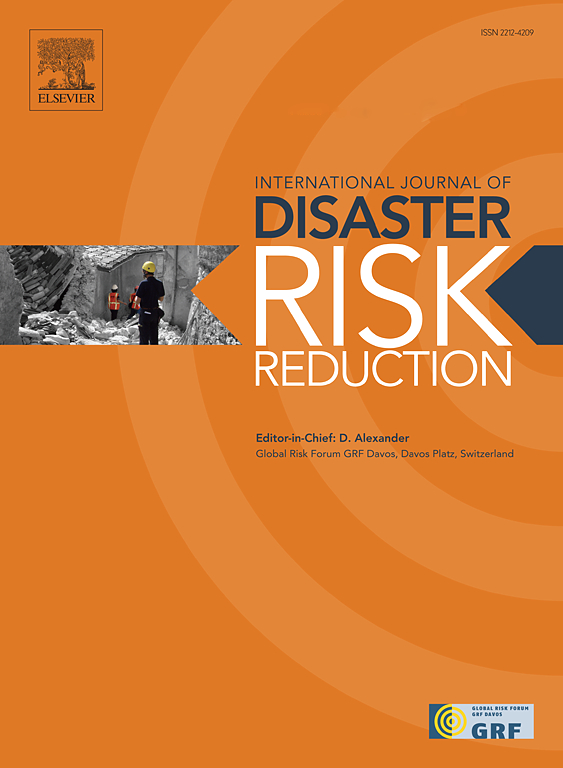规范学习促成行为改变:预防溺水案例
IF 4.2
1区 地球科学
Q1 GEOSCIENCES, MULTIDISCIPLINARY
International journal of disaster risk reduction
Pub Date : 2024-11-01
DOI:10.1016/j.ijdrr.2024.104942
引用次数: 0
摘要
溺水是一个具有全球意义的风险治理问题。大多数沿海溺水事件都发生在没有巡逻的海滩上。旨在影响公众行为的干预措施是以 "提高意识 "和 "行动意愿 "而非实际 "采取的行为 "来衡量的。因此,扩大影响的假设是,信息传播可以提高全社会的意识,从而改变全社会的行为。但是,目前还没有任何预防沿海溺水的干预措施能确定提高意识对实际行为的影响,因此,干预措施目前还无法确定改变后的行为是否会 "溢出 "到未受监控的地点;此外,也没有任何研究采用混合方法来解释行为改变或溢出效应的机制。我们进行了一项干预,将 20 分钟的安全课程与涉及积极反思的有意义的参与结合起来。该干预措施与仅涉及参与的对照组配对。这项研究在澳大利亚洛恩进行,共有 12 节课,约 600 人参加;4-6 个月后,我们与参加者取得联系,以衡量其影响。在筛选出返回海滩并有机会改变行为的参与者后,统计模型显示,与对照组相比,干预措施显著增加了采用风险缓解行为的人数、未被告知的非参与者人数,以及在无人看守海滩采用行为改变的人数。干预措施的主要影响途径是规范性学习,而不是提高认识。定性分析解释了干预措施如何支持规范性学习(即通过反思),以及规范性学习支持行为改变的机制(即自我效能和改变世界观)。我们展示了一种参与式方法和创新的混合方法,这种方法导致了实际的行为改变,并波及到非参与者和溺水事件集中的地点。从更广泛的意义上讲,这对将提高认识作为风险管理的基础提出了挑战。本文章由计算机程序翻译,如有差异,请以英文原文为准。
Normative learning generates behaviour change: The case of drowning prevention
Drowning is a risk governance issue of global significance. The majority of coastal drownings occur at unpatrolled beaches. Interventions designed to influence public behaviours are measured in terms of ‘awareness raised’ and ‘intentions to act’ rather than actual ‘behaviours adopted’. As a result, up-scaling impacts defaults to the dubious assumption that the communication of information can raise societal-scale awareness that will result in societal-scale behaviour change. No interventions into coastal drowning prevention, though, have determined the impacts of raised awareness on actual behaviours and, as a result, interventions are presently blind to whether changed behaviours ‘spillover’ to unpatrolled locations; further, no research has applied mixed methods to explain the mechanisms of behaviour changes or spillover effects. We conducted an intervention that combines a 20-min safety lesson with a meaningful engagement involving active reflection. This intervention was paired with a control that involved the engagement only. The study was conducted at Lorne, Australia, and involved 12 lessons with approximately 600 participants; 4–6 months later, participants were contacted to measure impact. After screening for those who had returned to a beach and had had opportunity to alter their behaviours, statistical modelling shows that, relative to the control, the intervention significantly increased the number of risk mitigation behaviours adopted, the number of non-participants told, and the number of behaviour changes adopted at unpatrolled beaches. The major impact pathway of the intervention was normative learning rather than awareness raising. Qualitative analysis explains how the intervention supported normative learning (i.e., through reflection) and the mechanisms through which normative learning supported behaviour change (i.e., self-efficacy and altered worldview). We demonstrate a participatory methodology and innovative mixed-methods approach that results in actual behaviour changes that spillover to non-participants and to the locations where drownings concentrate. More broadly, the implications challenge awareness raising as the basis of risk management.
求助全文
通过发布文献求助,成功后即可免费获取论文全文。
去求助
来源期刊

International journal of disaster risk reduction
GEOSCIENCES, MULTIDISCIPLINARYMETEOROLOGY-METEOROLOGY & ATMOSPHERIC SCIENCES
CiteScore
8.70
自引率
18.00%
发文量
688
审稿时长
79 days
期刊介绍:
The International Journal of Disaster Risk Reduction (IJDRR) is the journal for researchers, policymakers and practitioners across diverse disciplines: earth sciences and their implications; environmental sciences; engineering; urban studies; geography; and the social sciences. IJDRR publishes fundamental and applied research, critical reviews, policy papers and case studies with a particular focus on multi-disciplinary research that aims to reduce the impact of natural, technological, social and intentional disasters. IJDRR stimulates exchange of ideas and knowledge transfer on disaster research, mitigation, adaptation, prevention and risk reduction at all geographical scales: local, national and international.
Key topics:-
-multifaceted disaster and cascading disasters
-the development of disaster risk reduction strategies and techniques
-discussion and development of effective warning and educational systems for risk management at all levels
-disasters associated with climate change
-vulnerability analysis and vulnerability trends
-emerging risks
-resilience against disasters.
The journal particularly encourages papers that approach risk from a multi-disciplinary perspective.
 求助内容:
求助内容: 应助结果提醒方式:
应助结果提醒方式:


